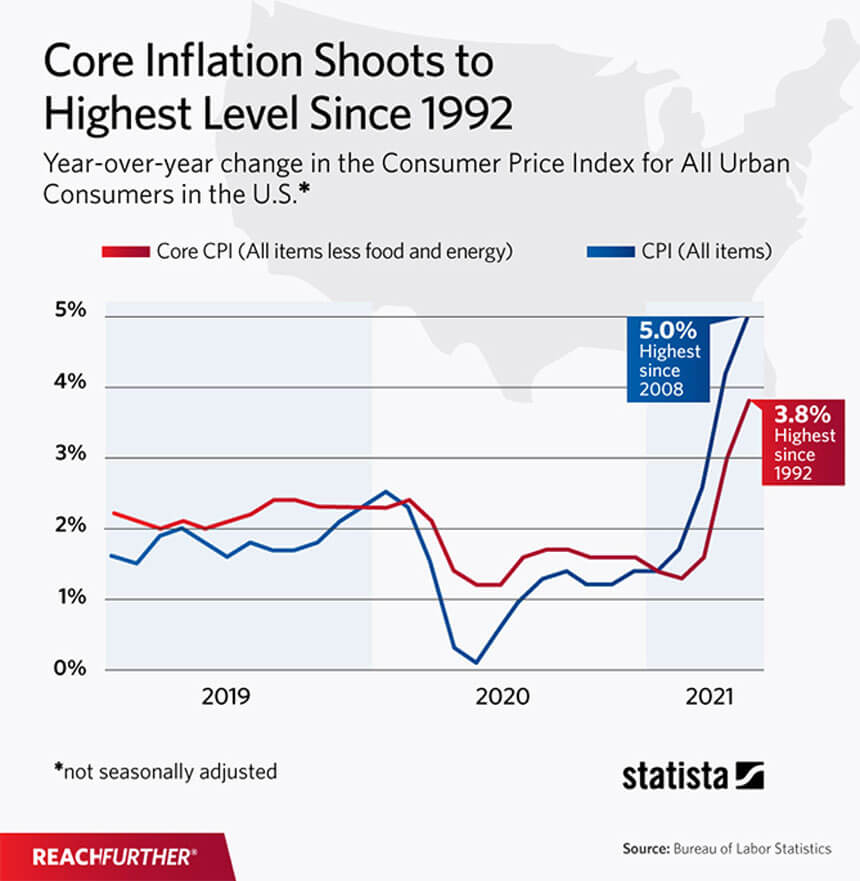Insights
How Investors Can Prepare for Inflation
By Andy Peters

Various options and tools that can help you navigate inflation
Sean Chapman, a carpenter in Eugene, Oregon, recently reviewed the price schedule for the various services he provides, such as home remodeling and woodworking.
He typically tries to keep the cost of his services in line with the local market. But this year, Chapman said, he decided it was time for a significant price increase.
The reason? Inflation is on the rise, and Chapman didn’t want to fall behind by charging too little. Also, he believes he provides superior service and the higher prices are justified.
“I work hard to boost my image as a contractor and show potential customers the higher quality of my services,” he said.
Inflation—the economic concept of an increase in prices and a decrease in the purchasing power of money over time—is something that Americans have had little reason to worry about lately. Even during recent economic downturns like the Great Recession, inflation rarely emerged as a source of trouble.
Prices rising
That has begun to change as consumer prices have been on the rise this year. The trend prompted the Federal Reserve Bank to move up by a year its plan to raise interest rates to combat inflation.
Entrepreneurs like Chapman can calibrate the prices they charge customers to reflect current economic trends. That’s not the case for many Americans who don’t work for themselves.
The recent headlines forecasting rate hikes and inflation usually grab the attention of investors, said Peter Hong, certified financial planner, chartered financial consultant, chartered life underwriter and senior vice president in the wealth management division at East West Bank. Many commercial and consumer clients have been contacting the financial consultants working at the bank branches this spring and summer to ask what they should do. They include people who are self-employed and those who work for an organization.
“People are concerned but not panicking,” Hong said. “Have you been to Costco recently? You can’t help but notice that prices are going up.”

Fund flows
Once it appeared that inflation might be taking hold, some investors quickly shifted their money. During the week of June 9, investors sold $17.6 billion in U.S. equity-based mutual funds, according to Reuters. It was the largest outflow in a six-week period for the mutual fund category.
Investors may have been reacting to data released that week showing U.S. consumer prices rose 5% in May compared to the same period a year earlier. That was the largest annual increase in consumer prices in 13 years, Reuters reported.
Inflation fears appeared to cool somewhat later in June, when Federal Reserve Bank chairman Jerome Powell said that high inflation would likely wane and that price increases will be temporary.
Careful planning
But Main Street individuals, families and entrepreneurs now have inflation on their minds, Hong said. It’s important, he added, to not panic.
Inflation can be managed through careful financial planning, diversifying your portfolio and seeking out tax-free and tax-deferred investments, some of which are principal protected while others are principal and interest guaranteed with high interest rates, according to Hong. Limiting investments to savings vehicles in an inflationary environment isn’t wise, Hong said.
“Cash has its place, but if you use cash as your main or only savings tool in a high inflation environment, you’ll be losing purchasing power pretty quickly,” he said.
Hong advises people that one of the first moves they should make is shifting out of long-term bonds and into short or ultra-short duration bonds. Some high-quality short duration and ultra-short duration bond funds, or high-quality cash/bond alternative funds invested in high-quality bank loans with liquidity and low fluctuation in net asset values could be great options.
“If you put your money in long-term bonds and rates go up, your bond portfolio value could go down,” Hong said. “Duration is important right now.”
Interest rates
There is a chance, however, that inflation could be here for the long run, Bloomberg reported former Treasury Secretary Robert Rubin as saying on June 28. If that possibility becomes more likely, the Fed could move even faster to begin raising rates. Interest rates in the U.S. have been near zero for more than a year.
For the time being, however, the Fed does not plan to raise rates until 2023 at the earliest. That gives investors some breathing room, according to economists.
Even in the event of a rate hike in 2023, “interest rates will remain historically low, probably well into 2024 and beyond,” said Richard Branch, chief economist at Dodge Data & Analytics, a provider of financial information to the commercial construction industry.

“Cash has its place, but if you use cash as your main or only savings tool in a high inflation environment, you’ll be losing purchasing power pretty quickly.”
Still, a rate hike is not necessarily a bad thing. U.S. Treasury Secretary Janet Yellen said in early June that higher interest rates “would actually be a plus for society’s point of view and the Fed’s point of view.”
Those who have placed money in money market funds or other low-risk, low-rate vehicles have earned paltry returns for years, Hong said. Persons nearing retirement frequently fall in that category. Those savers will get a boost if the Fed raises rates, and banks, in turn, increase their own rates on savings accounts.
Fixed annuities and fixed index annuities
But low returns on savings carry the risk of being outpaced by inflation, Hong said. Some better options could be fixed annuities or index annuities, he suggested. The fixed rates often are much higher than certificate of deposit rates, but they are guaranteed by the annuity carriers.
“The principal is guaranteed by the provider of the annuity based on their credit rating,” he said.
Fixed index annuity guarantees the principal. However, if the market index goes up, you capture a portion of the upside of market. Some of them may even guarantee that at the end of the term, a certain interest rate is guaranteed if the index has no growth. Many investors like using a combination of fixed annuity with a fixed index annuity, so as not to lock themselves into lower rates in a rising interest rate environment while capturing a portion of the market upside on a rising market cycle.
With a fixed annuity, the investor can choose to receive a payout that begins within 12 months of the initial payment to the insurance company that distributes the annuity, according to Clark Howard, a consumer advocate who broadcasts his advice on a nationally syndicated radio program. An investor can also defer the payout to a later date.
But it makes little sense to simply sit on cash out of fear, Hong said. Inflation may cause some broad-based economic hardships, but it’s something that can be managed if investors take the right steps. Otherwise, investors run a risk in the opposite direction—their savings are outpaced by inflation, thus losing purchasing power.
“Hoarding cash or doing nothing is the equivalent of burying one’s head in the sand,” Hong said.
To speak to an East West Bank Wealth Management advisor, click here.

